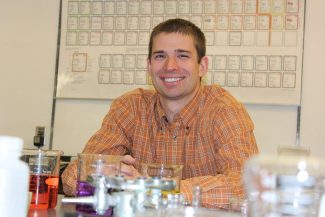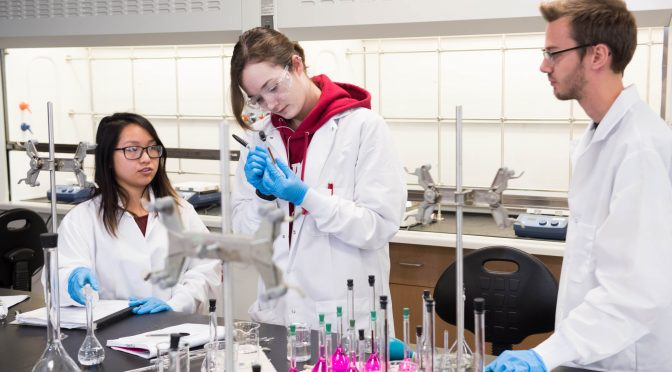The multimillion-dollar building has been built and students and faculty alike are thrilled with the opportunities that the Bishop Gerber Science Center provides. The devices and tools in the science center give Newman student hands-on experience that can’t be found just anywhere. The chemistry department plans to finish off this eventful semester with even more activity.
During fall break, the chemistry faculty will participate in training for an X-ray fluorescence spectroscopy (XRF). XRF is used to detect and determine the quantities of different elements in a sample. It can be used for liquids or solids.
Ryan Huschka, assistant professor of chemistry, said, “Once we are trained on the XRF, students are going to use the instrument for a variety of undergraduate labs and research projects, such as for Bob Diepenbrock, where students will be determining the accurate percent composition of insecticides and pesticides.”
Huschka was also trained on a recently purchased device called a high-performance liquid chromatograph (HPLC). HPLC is a system used in analytical chemistry to separate, identify and quantify each component in a mixture. He will implement this instrument into Analytical Chemistry this fall.

Huschka pointed out that at most universities undergraduate students aren’t usually permitted to work with these tools but rather watch their teachers and learn from viewing.
“It is difficult to overstate the amazing opportunity that students receive when they get hands-on experience at the undergraduate level … students are not just watching, they are actively involved in both labs and research,” said Huschka. He also mentioned a fitting quote by Benjamin Franklin; “Tell me and I forget. Teach me and I may remember. Involve me and I learn.”
Students in Organic Chemistry and Analytical Chemistry 2 have begun working with a nuclear magnetic resonance (NMR) spectroscopy and collecting spectra for a set of representative organic compounds. NMR is used to determine how atoms containing carbon and hydrogen are connected to one another. With this device, students will routinely collect infrared (IR) and NMR spectra. Huschka said, “It is wonderful to have students analyze their products immediately after synthesizing a chemical in the lab.”
An Advion mass spectrometer is also available to the students. The device measures the mass of molecules to identify unknown compounds. “It is capable of obtaining a mass spectrum in less than 10 seconds,” said Huschka. “Mass spectroscopy is used in a wide variety of science and multiple Nobel Prizes have been awarded to scientists for their work using mass spectroscopy.”
Atomic absorption spectrometry, infrared spectroscopy, gas chromatography-mass spectrometry and ultraviolet and visible spectroscopy are among the other tools being utilized in the classroom.
Huschka said, “We are incredibly blessed here at Newman to be given the capability to teach our students with these amazing and cool instruments. We look forward to innovating our curriculum in order to give our students the best in hands-on science instruction.”
For more innovative science happening at Newman, read part one of this two-part series.


